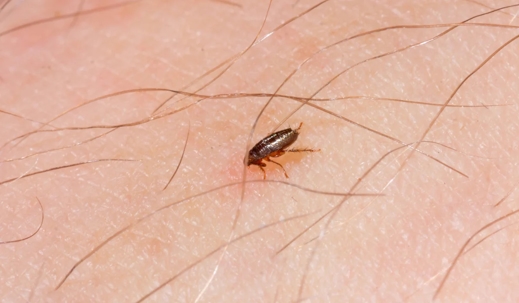Where Do Fleas Hide in Your Florida Home?
Fleas may be small, but they cause big problems when they invade your home. These pesky insects typically hide in places that offer warmth, moisture, and easy access to their next blood meal.
Does this mean your pet's favorite resting spots are at risk, too? Keep reading to uncover every hidden nook and cranny where these critters might be lurking.
Key Takeaways
- Fleas thrive in warm, hidden spots near pets, especially in pet areas and seldom-used spaces like guest rooms.
- Treat pets regularly with vet-recommended products and clean the home thoroughly to disrupt the flea life cycle.
- Professional pest control provides targeted treatments and follow-ups to eliminate fleas effectively.
Where Do Fleas Hide?
.2410192359501.webp)
Fleas often seek warm, hidden spots to thrive, especially those close to pets and household traffic. These environments provide ideal conditions for their life cycle.
Pet Areas
Pet areas are prime spots for female fleas to hide and lay eggs. Since they’re drawn to the carbon dioxide exhaled by cats and dogs, they embed themselves in pet bedding and fur. As a result, flea eggs and larvae can accumulate where pets sleep.
Pet areas often include pet beds, crates, and other frequent animal resting spots. Fleas also enjoy the cozy confines of pet hair that may collect in these areas, turning them into nursery grounds for flea eggs.
Beyond the Pet Zone
Fleas don't just stick to the pets themselves. They spread throughout the house, finding similar cozy locations.
Frequently, these pests move into carpeting, upholstery, and the small crevices between floorboards, which offer plenty of shelter and food opportunities.
Due to the favorable conditions of warmth and darkness, floor crevices and upholstery are high-traffic flea zones. Flea larvae can thrive in these places, developing into adult fleas that continue the cycle.
Other Places to Look
Dog and cat fleas are adept at hiding in places you might not immediately think to check. Hence, these overlooked areas can harbor flea populations.
Guest Rooms and Less-Used Spaces
Guest rooms and rarely visited spaces in the house can turn into flea havens. Since these rooms are not often disturbed, fleas can breed undisturbed, and their life stages, like pupae and cocoons, can thrive.
While checking these areas, look at the typical hiding spots like:
- Under beds and furniture: Fleas and other pests like bed bugs can hide in dust and debris.
- Closet corners: Fleas find these quiet spots ideal for breeding.
- Bedding and blankets: Fleas might settle in unwashed bedding, mixing with potential bed bugs.
Think Outside the House
Fleas don’t limit themselves to the interiors of your home. When inspecting, check areas where pets frequently rest or pass through, like:
- Patios and decks: Fleas might be found in crevices or pet bedding areas.
- Garage corners: Dusty, dark areas provide excellent conditions for fleas, pupae, and cocoons.
- Outdoor furniture: Fleas can nest in cushions and wooden areas frequently visited by pets.
Signs of Flea Infestations
Pets often harbor fleas, which can lead to serious health issues. To maintain pet health, check these flea signs that indicate a potential problem:
Signs on Your Pet | Description |
Scratching | Pets scratch more frequently due to flea bites from feeding blood meal. |
Red Bumps | Small red bumps often appear on the skin, particularly around the neck and tail. |
Adult Fleas | Tiny, fast-moving insects can be seen in the fur. |
Flea Dirt | Small black specks, which are flea feces, might be noticeable. |
Hair Loss | Patches of missing fur can result from constant scratching. |
Fleas don't just stay on pets; they can infest various areas in a home. Signs that your home has flea problems include:
Signs in Your Home | Description |
Flea Dirt in Bedding | Black specks in pet bedding are often flea feces. |
Larvae in Carpets | Flea larvae might be spotted deep in carpet fibers. |
Increased Pest Sightings | Adult fleas might be seen jumping around. |
Red Marks on the Skin | You might notice flea bites on their ankles. |
Regular Itching | Frequent itching among household members as they feed on human blood. |
To confirm your suspicion of fleas, you can conduct a white-sock test. Walk around the home while wearing white socks to attract fleas to your legs, making them easier to spot.
When to Call a Professional
Sometimes, store-bought pesticides just aren’t enough. So, if you or your pets get constant bites despite using flea-prevention products, it’s time to call a professional pest control company (like us at Native Pest Management).
As professionals, we have specialized treatment options beyond typical store-bought solutions. In some cases, just the peace of mind knowing we’re handling the situation can make a huge difference.
